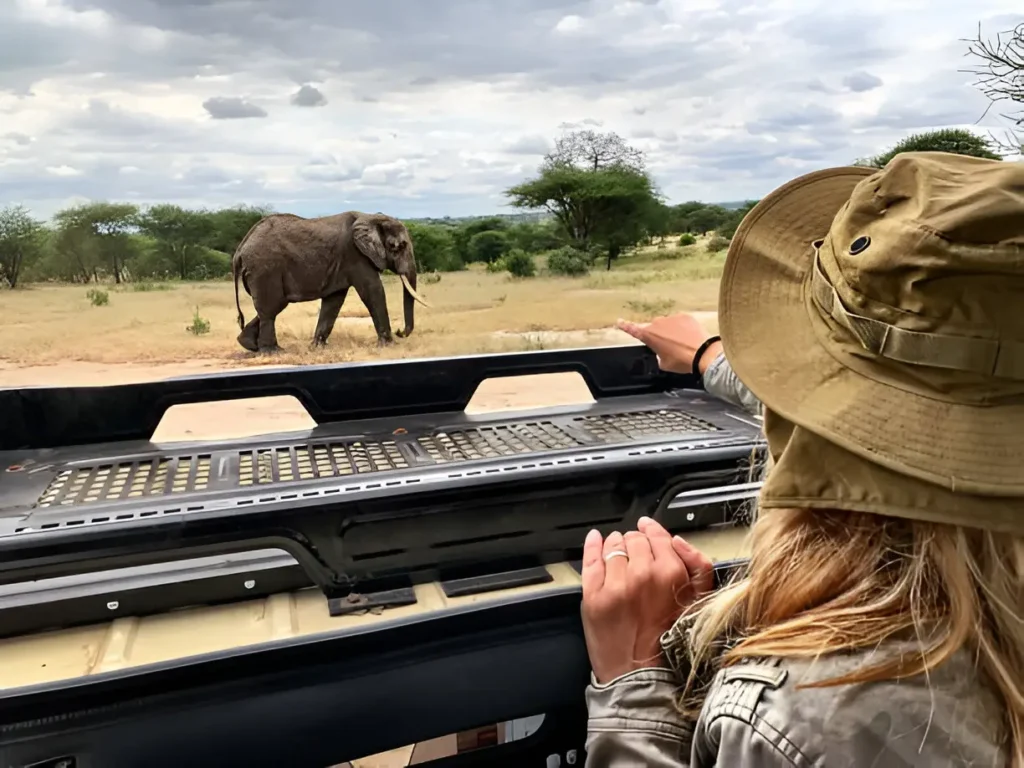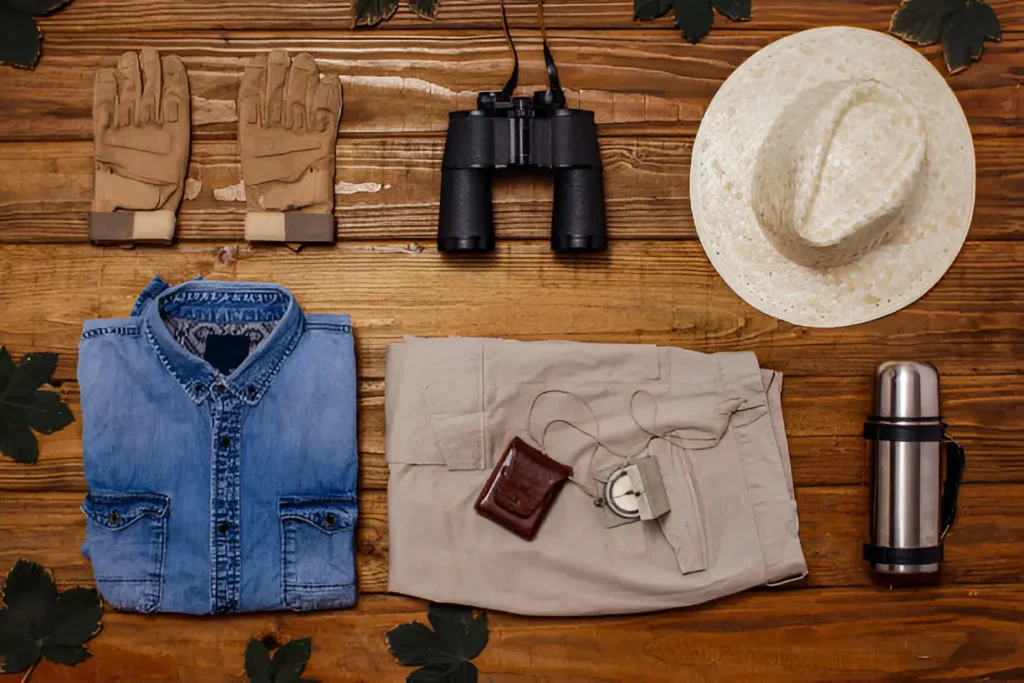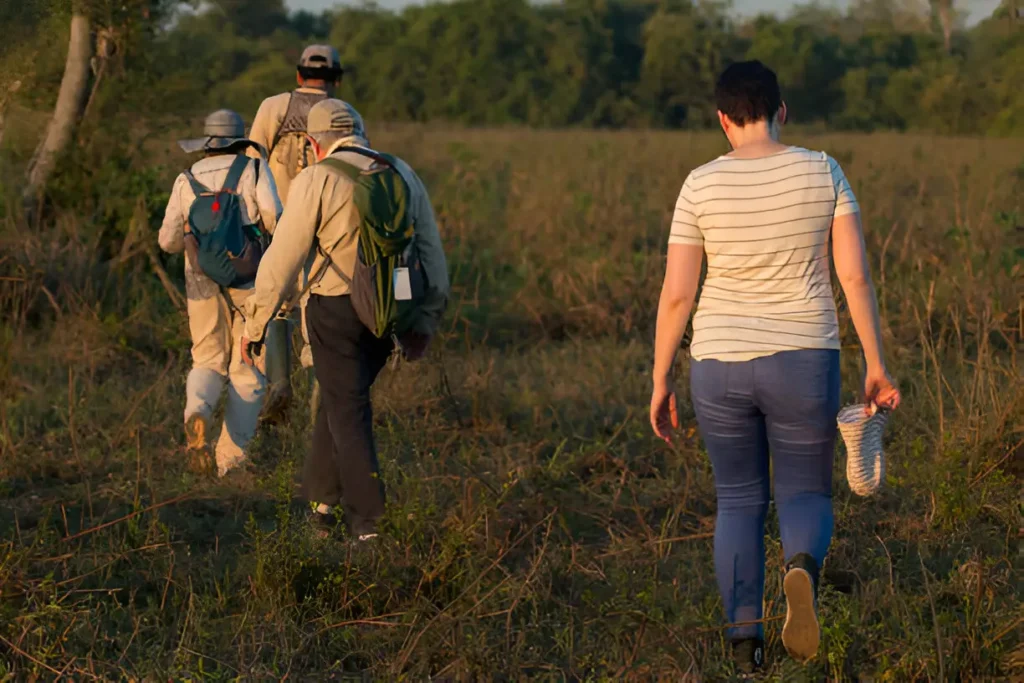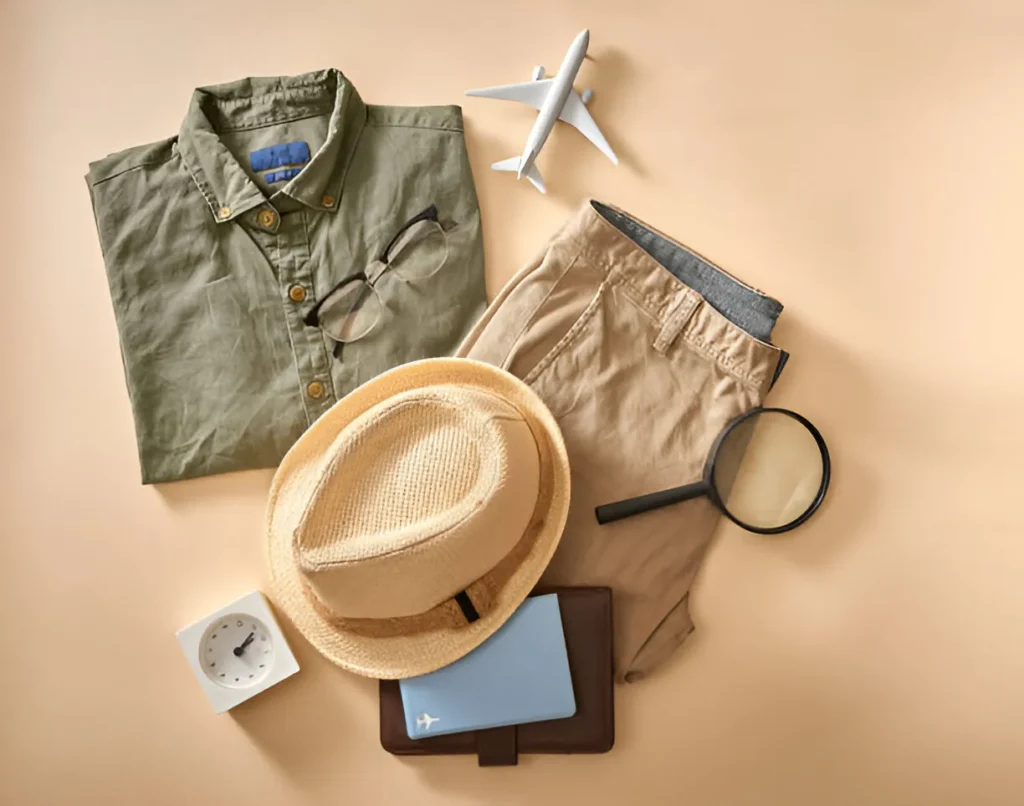Embarking on a safari adventure is thrilling and demanding, and proper preparation is key. One of the most crucial aspects is selecting the right safari outfit to ensure comfort, safety, and practicality. This article will guide you through the essential factors for choosing a perfect safari outfit, covering materials, styles, and practical tips for different safari environments. With the right safari outfit, you’ll be well-prepared to enjoy an unforgettable journey through diverse landscapes.
Table of Contents
Basic Information: Understanding the Safari Adventure

A safari is an adventurous journey into the wild, typically undertaken in Africa, though safaris can also be experienced in other parts of the world. This type of travel offers a rare opportunity to observe wildlife in their natural habitats, whether on a jeep, walking, or night safari. Choosing the right safari adventure outfit is crucial for both comfort and safety, ensuring that you are well-prepared for the unique challenges of the terrain, climate, and activities.
Geographical Location and Climate Considerations
Most safaris occur in regions with hot and dry climates, such as sub-Saharan Africa. Daytime temperatures can soar, often reaching over 30°C (86°F), while early mornings and evenings can become cooler, especially in the desert or savannah. In contrast, some safari destinations, like rainforests or wetlands, can experience high humidity or sudden rainfall.
Understanding the climate of your specific safari destination is key to choosing the right outfit. For instance, breathable and moisture-wicking clothing is essential in more humid or rainy environments to keep you comfortable. Conversely, for hot, dry climates, lightweight fabrics that offer UV protection are critical for shielding your skin from the harsh sun.
Best Time to Visit
The best time for a safari largely depends on the region you’re visiting. In Africa, the dry season (typically from June to October) is often considered the peak safari season, as animals congregate around water sources, making them easier to spot. However, this also means it can be hotter, so dressing appropriately for the weather is crucial. The wet season (November to March) is less crowded, and the landscape is lush, but it can bring unpredictable rain and cooler temperatures in some areas.
By knowing when you’re going and understanding the climate of your destination, you can make better clothing choices to stay comfortable and enjoy your Safari to the fullest.
Primary Content: Choosing the Perfect Safari Adventure Outfit

When selecting a safari adventure outfit, it’s essential to consider the various environments you’ll encounter and the types of activities you’ll participate in. Whether you’re embarking on a jeep safari, a walking safari, or a night safari, your outfit should be designed to keep you comfortable, safe, and well-prepared for all scenarios. Below, we’ll break down key factors and offer tips for choosing the ideal safari adventure outfit.
A. General Tips for the Perfect Safari Outfit
1. Fabric Selection: Breathable and Lightweight
Fabric is one of the most critical factors when choosing a safari outfit. Since you’ll be spending long hours in hot, often humid conditions, wearing breathable, moisture-wicking fabrics is crucial. Fabrics like cotton, linen, and specialized blends for outdoor wear are perfect for hot climates, allowing air to circulate while drawing moisture away from your skin. Avoid heavy, non-breathable materials, as they can leave you feeling sticky and uncomfortable.
2. Layering for Flexibility
Even in warmer climates, mornings and evenings on Safari can be surprisingly chilly. Layering is the key to managing varying temperatures. Start with a moisture-wicking base layer, then add lightweight shirts, long-sleeve options, and a light jacket for the cooler parts of the day. Having a few layers allows you to adjust your clothing as temperatures fluctuate throughout the day.
3. Neutral Colors for Comfort and Safety
Regarding safari outfits, neutral tones such as khaki, beige, olive, and brown are recommended. These colors help you blend in with the environment, reducing your visibility to wildlife and minimizing the risk of attracting insects like mosquitoes drawn to brighter colors. Additionally, neutral colors are practical as they won’t show dirt as easily, keeping you looking fresh even after a full day of exploration.
4. Sun Protection
A safari usually involves long hours of direct sun exposure, so protecting your skin is essential. Choose clothing with built-in UV protection, or wear items like wide-brimmed hats and long-sleeve shirts to keep the sun off your skin. Don’t forget sunscreen for exposed areas like your face, neck, and hands. Sunglasses with UV protection are also crucial to shield your eyes from the harsh sunlight.
5. Footwear for Comfort and Durability
Since safaris often involve walking through various terrains, comfortable and durable footwear is necessary. Opt for sturdy, closed-toe shoes, such as hiking boots or trail shoes, that support uneven surfaces and protect your feet from hazards like rocks and thorns. Choose footwear with breathable uppers to keep your feet cool and comfortable throughout the day.
B. Specialized Safari Outfits for Different Activities
1. Walking Safari

Comfort and flexibility are the top priorities for a walking safari. You’ll be on your feet for extended periods, so breathable clothing, sturdy footwear, and a comfortable hat are essential. Wear lightweight, moisture-wicking fabrics and long pants to protect yourself from bugs, thorny bushes, and the sun. If you’re visiting a destination with high mosquito activity, consider clothing treated with insect repellent for extra protection.
2. Jeep Safari
Your outfit can be more relaxed during a jeep safari, but comfort is still key. Since you’ll likely be sitting for long periods, opt for comfortable pants or shorts that allow for freedom of movement. Pair them with a breathable shirt or top that protects you from the sun. Bring a light jacket or sweater for cooler early mornings or evenings. Don’t forget a hat and sunglasses for protection from the direct sun while riding in the open jeep.
3. Night Safari
A night safari requires different considerations, as temperatures can drop after sunset, and you may encounter wildlife in low-light conditions. For this, a good combination of layers is essential. Wear a lightweight long-sleeve shirt or jacket for warmth, and ensure that your outfit has light-reflective elements or is easy to spot in the dark. A flashlight or headlamp can be a handy accessory. Since night safaris may be buggy, wear long sleeves and pants to avoid insect bites.
C. Mistakes to Avoid When Selecting Safari Clothing
1. Overpacking
It can be tempting to bring every item you might need, but overpacking can be cumbersome. Stick to essentials and focus on versatile, mixed, and matched clothing. Choose items that can be easily washed and dried overnight, so you don’t need to bring excess clothing.
2. Wearing the Wrong Fabrics
Avoid synthetic fabrics like polyester or nylon, as they can trap moisture and make you sweaty and uncomfortable. Also, avoid clothing made from heavy materials that won’t breathe or keep you cool. Always prioritize lightweight, breathable, and moisture-wicking fabrics.
3. Forgetting Protection from Bugs
Insects, particularly mosquitoes, are common in many safari destinations. Not wearing insect-repellent clothing or forgetting to pack mosquito repellent can lead to uncomfortable bites and possible health risks. Always wear long sleeves and pants if you’re in areas where bugs are prevalent, and choose clothing with built-in insect-repelling technology if possible.
4. Neglecting Footwear Comfort
Wearing new shoes or sandals that aren’t broken in can cause blisters and discomfort during your Safari. Always wear footwear that you know will be comfortable for long walks and rugged terrain. Sturdy, well-worn shoes with good support are a must.
Stay tuned as we dive into additional recommendations and tips for creating the perfect safari wardrobe in the next section!
Additional Recommendations and Tips for Your Safari Adventure Outfit

When it comes to preparing for a safari, every detail counts. To ensure you’re fully equipped for the adventure, here are some additional tips and recommendations to help you improve your experience and stay comfortable throughout your journey. These insights will ensure you’re well-prepared, safe, and able to focus on the beauty of the Safari without worrying about your outfit or accessories.
1. Pack Smart with Versatile Clothing
One of the best ways to stay comfortable on your Safari is to pack only the essentials. Since safaris are often in remote areas with limited access to shopping, packing versatile, multi-purpose clothing is a smart strategy. Choose clothing items that can be easily layered for changing weather conditions. Light jackets, convertible pants, and moisture-wicking shirts can be worn for multiple activities, minimizing the need to pack too much.
Consider packing a lightweight scarf or shawl that can double as sun protection or a lightweight blanket for chilly mornings and evenings. These versatile pieces will help you maintain comfort and adjust to varying temperatures while not taking up much space in your luggage.
2. Protect Your Skin and Eyes with the Right Accessories
While clothing plays a significant role in your comfort, accessories like hats, sunglasses, and sunscreen are equally crucial in protecting your skin and eyes from the harsh elements of the safari environment. A wide-brimmed hat made from lightweight material protects you from the sun, helping to keep you cool and shield your face, neck, and ears from direct sunlight.
Sunglasses with UV protection are essential to guard against the sun’s harmful rays. Polarized lenses will also reduce glare and help you see clearly, whether observing wildlife or enjoying the scenic landscape. Don’t forget to apply sunscreen regularly, especially to exposed areas such as your face, ears, and hands.
3. Use Insect Repellent and Bug-Proof Clothing
Mosquitoes and other insects can be an issue in many safari destinations. To avoid itchy bites or even dangerous diseases, it’s important to wear clothing that provides some protection. Look for clothing treated with insect-repellent technology, or you can apply insect repellent directly to your skin and clothing.
Long sleeves, pants made from lightweight materials, and closed-toe shoes will help keep bugs at bay while you explore. Additionally, consider bringing an insect-repellent spray or lotion for your skin and spraying your tent or camping area before settling down for the night.
4. Stay Hydrated and Keep a Water Bottle Handy
While this isn’t necessarily related to clothing, staying hydrated on your Safari is essential. Many safari regions’ hot, dry environments can lead to dehydration, so always carry a reusable water bottle. Choose a durable, insulated water bottle that will keep your water cool for hours and won’t break easily. Many safari outfits feature hidden pockets or accessories to store your bottle for easy access during your journey.
5. Prepare for Dust and Dirt
Safaris often involve off-road driving or walking through dusty paths, especially in more rugged areas. Wearing clothing resistant to dust and dirt is crucial to maintaining comfort and cleanliness. Opt for fabrics that can be easily shaken off or brushed clean. Avoid wearing white or light-colored clothing that will quickly show dirt.
It’s also a good idea to bring a small travel-sized cleaning cloth or wet wipes to clean your hands and face after long excursions in dusty areas. Extra items like a portable face mask can also help protect your lungs from inhaling too much dust, especially on a dusty Jeep safari ride.
6. Consider Safari-Specific Gear
If you’re going on a specialized safari, such as a bird-watching or a photographic safari, you should invest in additional gear that complements your outfit. For bird-watching, lightweight binoculars, a small field guide, and a camera bag with a waterproof cover can be beneficial. Photographers should bring appropriate camera gear, including lens cleaners, caps, and extra batteries, as safaris often involve long hours of outdoor activity.
In some safari locations, wearing protective gloves is advisable if you’re handling equipment or exploring areas with rough terrain. Suitable gloves will also provide extra protection from scrapes or insect bites.
7. Choose Eco-Friendly and Sustainable Options
In today’s travel landscape, eco-friendly and sustainable practices are more critical than ever. When selecting your safari adventure outfit, consider choosing clothing and accessories made from sustainable materials. Many outdoor brands now offer eco-friendly options, including clothing made from recycled or biodegradable fabrics. These choices will reduce your environmental impact and contribute to a cleaner, more sustainable safari experience.
By choosing ethically produced items, you are supporting eco-friendly practices in the travel industry and ensuring that future generations can enjoy the incredible wildlife and landscapes you’re exploring.
Conclusion: Perfecting Your Safari Adventure Outfit
With these additional tips and recommendations, you can fine-tune your safari adventure outfit to ensure maximum comfort, safety, and practicality. Whether exploring the African savannah, venturing through a jungle, or embarking on a desert safari, the proper safari adventure outfit and accessories will make all the difference. By choosing the right materials for your safari adventure outfit, protecting yourself from the elements and bugs, and staying mindful of local cultures and sustainability, you’ll be ready for an unforgettable safari experience.
If you’re ready to begin your journey, ensure your safari adventure outfit is up to the task! It’s time to pack your bags and embark on the adventure of a lifetime with confidence and comfort.
Explore the Frequently Asked Questions (FAQ) section below for more details and insights about preparing for your Safari or additional recommendations on safari gear and travel tips.
Frequently Asked Questions
1. What to wear with a safari jacket?
When wearing a safari jacket, it’s essential to pair it with lightweight, breathable fabrics underneath. This could mean a fitted shirt or blouse paired with lightweight pants or shorts for women. For men, a simple T-shirt or long-sleeve shirt will complement the jacket, paired with cargo pants or comfortable trousers. A safari jacket’s versatile design makes it easy to dress up or down based on the environment.
2. What to wear for a safari day at school?
For a safari-themed day at school, opt for comfortable, casual clothing that resembles what you’d wear on a safari. Think khaki shorts, light-colored shirts, and sturdy shoes. You can accessorize with a fun hat and a safari-themed bag or backpack. This will help you stay comfortable while embracing the adventure’s spirit.
3. What is a safari adventure outfit?
A safari adventure outfit is designed to be both functional and comfortable for travelers embarking on safari expeditions. Typically, it consists of lightweight, breathable fabrics, durable pants, long-sleeve shirts to protect from the sun and insects, and accessories like hats, sunglasses, and sunscreen. The outfit is intended to protect from the elements while allowing ease of movement during activities such as wildlife viewing, hiking, or off-road drives.
4. What to wear on an adventure?
On an adventure, it’s essential to wear clothing that offers comfort and practicality for the specific environment. Whether hiking, exploring deserts, or enjoying a jungle safari, lightweight and moisture-wicking fabrics are key. Opt for clothing that can handle a range of temperatures, such as layering options, and bring appropriate footwear like hiking boots or sturdy sandals. Accessories like hats, sunglasses, and a backpack will also add convenience and style.
